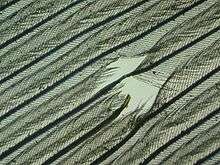Feather hole

Feather holes often characteristically occur on wing and tail feathers of some small-bodied species of passerines. In the case of barn swallows, it was suggested that the holes were feeding traces of avian lice, either Machaerilaemus malleus and/or Myrsidea rustica (both Phthiraptera: Amblycera).[1]
Hole counts were shown to be highly repeatable, and thus counts appeared to be useful measures to quantify the intensity of infestation. Since then, a number of influential papers have been published on the evolutionary, ecological, and behavioral aspects of host-parasite interactions based on the assumption that holes were chewed by Machaerilaemus malleus. More specifically, host sexual selection,[2] feather breakage,[3] flight performance,[4] immunity levels,[5] arrival dates,[6] and even song characteristics[7] were shown to covary with the number of holes. Cross-fostering experiments showed that infestation levels were heritable.[8]
Recently, however, it was shown that Machaerilaemus malleus is apparently absent from Europe, where all these studies were carried out. Correlational evidence supports the hypothesis that feather holes are feeding traces of lice, however, the occurrence of Brueelia spp. lice (Phthiraptera: Ischnocera) provides the best fit to the distribution and abundance of feather holes both in barn swallows and across several small passerines.[9]
References
- ↑ Møller, A. P. (1991). Parasites, sexual ornaments and mate choice in the Barn Swallow Hirundo rustica. In: Loye, J. E.; Zuk, M (eds) Bird-parasite interactions: Ecology, evolution, and behaviour. Oxford University Press. pp. 328–343.
- ↑ Kose, M.; Mand, R.; Møller, A. P. (1999). "Sexual selection for white tail spots in the barn swallow in relation to habitat choice by feather lice". Animal Behaviour. 58: 1201–1205. doi:10.1006/anbe.1999.1249. PMID 10600140.
- ↑ Kose, M.; Møller, A. P. (1999). "Sexual selection, feather breakage and parasites: the importance of white spots in the tail of the barn swallow (Hirundo rustica)". Behavioral Ecology and Sociobiology. 45: 430–436. doi:10.1007/s002650050581.
- ↑ Barbosa, A; Merino, S.; de Lope, F.; Møller, A.P. (2002). "Effects of feather lice on flight behavior of male Barn Swallows (Hirundo rustica)". The Auk. 119: 213–216. doi:10.2307/4090025.
- ↑ Møller, A. P.; de Lope, F; Saino, N. (2004). "Parasitism, immunity, and arrival date in a migratory bird, the Barn Swallow". Ecology. 85: 206–219. doi:10.1890/02-0451.
- ↑ Pap, P. L.; Tökölyi, J.; Szép, T. (2005). "Frequency and consequences of feather holes in barn swallows Hirundo rustica" (PDF). Ibis. 147: 169–175. doi:10.1111/j.1474-919x.2004.00386.x.
- ↑ Garamszegi, L. Z.; Heylen, D.; Møller, A. P.; Eens, M.; de Lope, F. (2005). "Age dependent health status and song characteristics in the barn swallow". Behavioral Ecology. 16: 580–591. doi:10.1093/beheco/ari029.
- ↑ Møller, A. P.; Martinelli, R.; Saino, N. (2004). "Genetic variation in infestation with a directly transmitted ectoparasite". Journal of Evolutionary Biology. 17: 41–47. doi:10.1046/j.1420-9101.2003.00660.x.
- ↑ Vas, Z.; Csörgő, T.; Møller, A. P; Rózsa, L. (2008). "The feather holes on the barn swallow Hirundo rustica and other small passerines are probably caused by Brueelia spp. lice" (PDF). Journal of Parasitology. 94: 1438–1440. doi:10.1645/GE-1542.1. PMID 18576840.